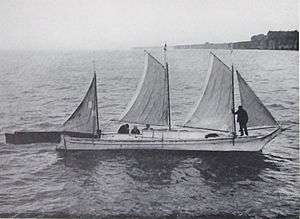Tilikum (boat)
 Tilikum at Margate with Captain John Voss standing at the bows | |
| History | |
|---|---|
| Name: | Tilikum |
| Owner: | Unknown Nootka woman |
| Cost: | $80, in silver, in April 1901 |
| Laid down: | Early 1800s |
| Acquired: | John Voss, 1901 |
| General characteristics | |
| Class and type: | Dugout canoe, of red cedar, rigged as a sailing canoe in 1901 |
| Length: | 38 ft. (12 m) |
| Sail plan: | Gaff-rigged schooner, 230 square ft. (21 m2) sail area, added for 1901 voyage |


Tilikum was a 38-foot (12 m) dugout canoe that was used in an effort to circumnavigate the globe starting in 1901. The boat was a "Nootkan" (Nuu-chah-nulth) canoe which was already old when she was obtained by captain John Voss in April 1901. The boat was built in the early 19th century as a dugout canoe made from a large red cedar log. Tilikum was purchased for $80 in silver from a native woman (Voss describes her as a "siwash") in a transference ceremony allegedly sealed by a bottle of rye whiskey - the name Tilikum means "friend" in Chinook jargon. Apparently, John Voss and his companion in this venture, Norman Luxton, were inspired by the voyage of Joshua Slocum, who sailed the 37-foot (11 m) sloop Spray around the world a few years earlier and wrote a best selling book about his adventures.
The boat was refitted - reinforced, covered and rigged with sail, 230 square feet (21 m2) in total, and readied for her voyage. Tilikum was sailed out of Oak Bay harbour on May 20, 1901, captained by Voss and mated by Luxton. After 10,000 miles (about 16000 km) and five months on the Pacific Ocean, Tilikum struck a reef and Luxton was thrown from the boat. His whole body was badly cut by coral. The boat limped into harbour at Penrhyn Island in the Cook Islands on 2 September 1901, and Luxton was forced to abandon the trip in Suva, Fiji on 17 October 1901.[1] Tilikum was mated by 10 more men between that time and when she finally pulled into harbour on the Thames in London, England in September, 1904.
On 25 October 1901, after leaving Suva, the mate, binnacle and compass were lost in 'large breaking seas'. Voss was now alone without a compass, 1,200 miles (1,900 km) from Sydney. Tilikum is claimed to be the smallest deep-water ship to have ever entered Sydney Harbour until this time.
Tilikum arrived in Melbourne on 13 March 1902 and was exhibited in full rig in Collins Street. She was moved to another vantage point at the Exhibition Buildings, but during loading onto a 'wagon', the hook broke and she was damaged, with splits appearing in five different places. Voss repaired her himself using thin steel ribs.
She was then sailed on Lake Wendouree, Ballarat, and presented with a new set of sails by local yachtsmen, before travelling to Geelong to be returned to the sea.
Voss was elected a Fellow of the Royal Geographical Society in London after lecturing in Britain about the voyage.
Captain John Voss published his sailing memoir as The Venturesome Voyages of Captain Voss[2] in 1913. Tilikum was placed on display in London and changed hands a number of times, losing her bowsprit and masts over time. In 1929, the Furness Shipping Line returned Tillikum to Victoria, British Columbia. She underwent restoration beginning in 1936 by the Thermopylae Club before she was moved into the Maritime Museum in 1965 and has remained on display there since.
Norman Luxton kept notes of the voyage; his Tilikum Journal, edited by his daughter Eleanor was published in 1971.[1]
References
- 1 2 Luxton, Norman; Luxton, Eleanor (1971). Luxton's Pacific crossing: being the journal of N.K. Luxton, mate of the Tilikum, May 20, 1901, Victoria, B.C. to October 18, 1901, Suva, Fiji. Gray.
- ↑ The Venturesome Voyages Of Captain Voss on the Internet Archive
Further reading
- The Age (Melbourne) 11, 14, 25 March 1902; 23 April 1902.
Coordinates: 48°25′33.26″N 123°22′7.66″W / 48.4259056°N 123.3687944°W